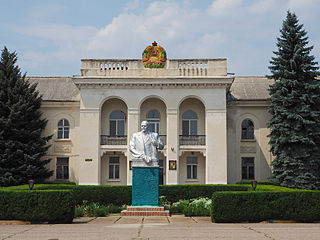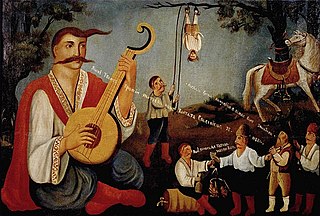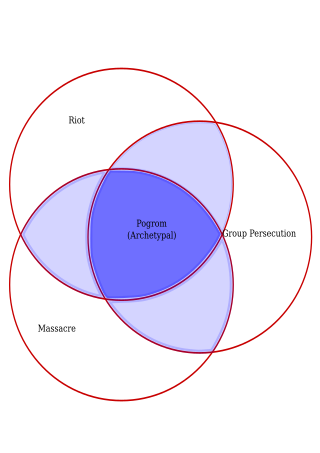Related Research Articles

A pogrom is a violent riot incited with the aim of massacring or expelling an ethnic or religious group, particularly Jews. The term entered the English language from Russian to describe 19th- and 20th-century attacks on Jews in the Russian Empire. Retrospectively, similar attacks against Jews which occurred in other times and places also became known as pogroms. Sometimes the word is used to describe publicly sanctioned purgative attacks against non-Jewish groups. The characteristics of a pogrom vary widely, depending on the specific incident, at times leading to, or culminating in, massacres.

Anton Ivanovich Denikin was a Russian military leader who served as the acting supreme ruler of the Russian State and the commander-in-chief of the armed forces of South Russia during the Russian Civil War of 1917–1923. Previously, he was a general in the Imperial Russian Army during World War I.

The Kishinev pogrom or Kishinev massacre was an anti-Jewish riot that took place in Kishinev, then the capital of the Bessarabia Governorate in the Russian Empire, on 19–21 April [O.S. 6–8 April] 1903. During the pogrom, which began on Easter Day, 49 Jews were killed, 92 were gravely injured, a number of Jewish women were raped, over 500 were lightly injured and 1,500 homes were damaged. American Jews began large-scale organized financial help, and assisted in emigration. The incident focused worldwide attention on the persecution of Jews within the Russian Empire, and led Theodor Herzl to propose the Uganda Scheme as a temporary refuge for the Jews. A second pogrom erupted in the city in October 1905.

Simon Dubnow was a Jewish-Russian historian, writer and activist.

Temporary regulations regarding the Jews were residency and business restrictions on Jews in the Russian Empire, proposed by minister Nikolay Pavlovich Ignatyev and enacted by Tsar Alexander III on 15 May, 1882. Originally, intended only as temporary measures, they remained in effect for more than thirty years.

The Black Hundreds were reactionary, monarchist, and ultra-nationalist groups in Russia in the early 20th century. They were staunch supporters of the House of Romanov, and opposed any retreat from the autocracy of the reigning monarch. Their name arose from the medieval concept of "black", or common (non-noble) people, organized into militias.

Dubăsari or Dubossary is a city in Transnistria, with a population of 23,650. Claimed by both the Republic of Moldova and the Transnistrian Moldavian Republic, the city is under the latter's administration, and functions as the seat of the Dubăsari District.
The history of the Jews in 19th-century Poland covers the period of Jewish-Polish history from the dismemberment of the Polish–Lithuanian Commonwealth, until the beginning of the 20th century.

The history of the Jews in Ukraine dates back over a thousand years; Jewish communities have existed in the modern territory of Ukraine from the time of the Kievan Rus'. Important Jewish religious and cultural movements, from Hasidism to Zionism, arose there. According to the World Jewish Congress, the Jewish community in Ukraine is Europe's fourth largest and the world's 11th largest.

The Kiev pogroms of 1919 refers to a series of anti-Jewish pogroms in various places around Kiev carried out by White Volunteer Army troops. The series of events concern the following districts:

A series of pogroms against Jews in the city of Odessa, Ukraine, then part of the Russian Empire, took place during the 19th and early 20th centuries. They occurred in 1821, 1859, 1871, 1881 and 1905.
The Warsaw pogrom was a pogrom that took place in Russian-controlled Warsaw on 25–27 December 1881, then part of Congress Poland in the Russian Empire, resulting in two people dead and 24 injured.

Antisemitism in Ukraine has been a historical issue in the country, particularly in the twentieth century. The history of the Jewish community of the region dates back to the era when ancient Greek colonies existed in it. A third of the Jews of Europe previously lived in Ukraine between 1791 and 1917, within the Pale of Settlement. The large concentration of Jews in this region historically made them an easy target for anti-Jewish actions and pogroms.
Pogroms in the Russian Empire were large-scale, targeted, and repeated anti-Jewish rioting that began in the 19th century. Pogroms began to occur after Imperial Russia, which previously had very few Jews, acquired territories with large Jewish populations from the Polish–Lithuanian Commonwealth and the Ottoman Empire from 1772 to 1815. These territories were designated "the Pale of Settlement" by the Imperial Russian government, within which Jews were reluctantly permitted to live. The Pale of Settlement primarily included the territories of Poland, Ukraine, Belarus, Bessarabia, Lithuania and Crimea. Jews were forbidden from moving to other parts of European Russia, unless they converted from Judaism or obtained a university diploma or first guild merchant status. Migration to the Caucasus, Siberia, the Far East or Central Asia was not restricted.
John Klier, was a British-American historian of Russian Jewry and a pivotal figure in academic Jewish studies and East European history in the UK and beyond. At the end of his career and life, Klier was the Sidney and Elizabeth Corob Professor of Modern Jewish History at University College London. He was a historian who challenged scholarly opinion on the Jewish community under the Tsars.

The Belostok (Białystok) pogrom occurred between 14–16 June 1906 in Białystok, Poland. During the pogrom, between 81 and 88 Jews were killed by soldiers of the Imperial Russian Army, the Black Hundreds, and about 80 people were wounded.
Antisemitism in the Russian Empire included numerous pogroms and the designation of the Pale of Settlement from which Jews were forbidden to migrate into the interior of Russia, unless they converted to the Russian Orthodox state religion.

This article provides a list of definitions of the term pogrom. The term originated as a loanword from the Russian verb громи́ть, meaning "to destroy, to wreak havoc, to demolish violently". The events in Odessa during Holy Week in 1871 were the first to be widely called a "pogrom" in Russian, and the events of 1881–82 introduced the term into common usage throughout the world.

The Kiev pogrom of 1881 lasted for three days starting 26 April, 1881 in the city of Kiev and spread to villages in the surrounding region. Sporadic violence continued until winter. It is considered the worst of the pogroms that swept through south-western Imperial Russia in 1881. Pogroms continued on through the summer, spreading across the territory of modern-day Ukraine including Podolia Governorate, Volyn Governorate, Chernigov Governorate, Yekaterinoslav Governorate, and others.

Nikolai Vasilyevich Kleigels was a Russian general, statesman, Adjutant-General, and also préfet de police of Saint Petersburg.
References
- Early Twentieth Century Timelines: Russia in Chaos Archived 2007-06-10 at the Wayback Machine
- William C. Fuller, The Foe Within: Fantasies of Treason and the End of Imperial Russia, 2006
- Michael F. Hamm, Kiev: A Portrait, 1800-1917, rev. ed. (Princeton, 1995), p. 191.
- S.N. Dubnow, History of the Jews in Russia and Poland from the Earliest Times Until the Present Day, trans. I. Friedlander, vol.2 (Philadelphia, 1920; repr., New York, 1972), p. 128.
- Herman Rosenthal Jewish Encyclopedia, volume I page 347 column 1 article "Alexander III., Alexandrovich